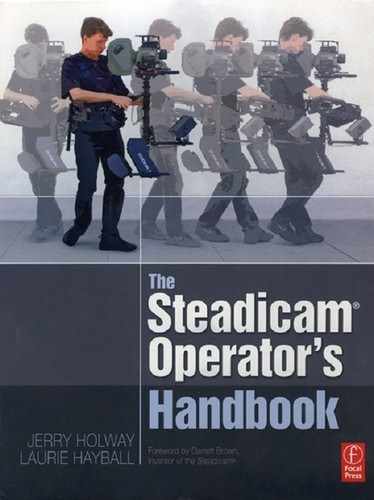Would you care to
dance?
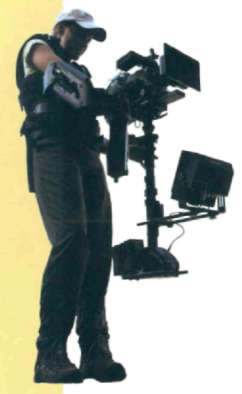
Steadicam operating has often been compared to dancing. Learning to work with the Steadicam as if it were your dance partner leads to good operating. Employing some dance techniques to maneuver the camera along its path is much more productive than muscling the rig about as if it were a ball and chain that you must drag from one place to the next
Operating a Steadicam is very similar to dancing — ballroom dancing.
For all you salsa fanatics out there, don't get too excited — hip movement is not conducive to good Steadicam operating. When you watch a master operator dance with his rig, the camera does not tug at the operator; the operator does not force the Steadicam. The Steadicam comes alive and appears to be perfectly executing its part of the dance.
Your primary goal is to do everything in your power to make the camera travel beautifully, smoothly along the predetermined path of the shot — without looking like you are struggling. This can be achieved by many of the same principles we find in dance: balance, tension, space, and timing.
Balance
The first step to good operating is finding your comfortable “sweet” spot where the rig hangs, balanced, with the least amount of effort. This is your ideal spot to place the rig, while you stand normally, without strain. The common center of gravity is between you and the rig. Maintain a balance around that center at all times.
You must be ready to shift your attention, move in another direction, alter your speed at any moment. It is critical to bring the rig with you — to lead your partner. Don't start forward or backward or turn without first sending the camera in the direction you want to go. Maintain good balance with the Steadicam and you can move the camera in any direction, flawlessly.
Tension
The process of balancing the Steadicam inches from your hip (by the long muscles in your back and down your legs) is marked by a kind of tension. In dance, there is a specific pressure that each partner maintains against the other in order to communicate intentions. This is how the man leads the woman through the dance,
However, if the woman fails to push back or resist to a certain degree, the man cannot effectively lead her anywhere. So the Steadicam can be considered the female dance partner, consistently delivering resistance in the form of weight, torque, and inertia.
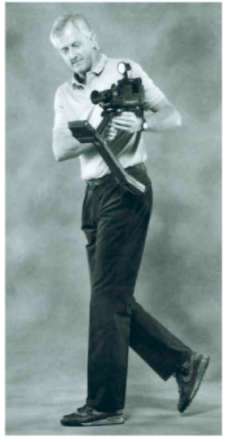
The tension of an operator is a certain insistence to maintain balance while urging the Steadicam to move in a certain way. Without it, the rig would fall away from the operator and probably pull him to the ground.
This tension is heightened depending on the shot and the concentration of the operator. At different points during a shot you will feel the need to increase tension. For example, when you make a slow and deliberate move past an object close to the lens, your body will tense as you focus on the object. At other times you might even feel relaxed: walking forward in Missionary with a wide lens.
It does follow that the slower the move, the more acutely focused you become, and the apparent tension rises.
Space
Dancers create space between them by gently applying pressure against their partner's hand. The more rigorous the movement, the more pressure is applied. The dance partners work to maintain this spatial relationship, regardless of the difficulties or intricacies in the choreographed dance. With a Steadicam, it is critical to maintain this space through balance and control.
You must never let the camera get too far away from you, or your “partner” will want to run away wildly. If you bring the rig in too close without shifting your balance, the camera might end up smacking you in the face. If you're thinking, “but I can balance it way out there,” just because you can maintain balance is not a good enough reason to do so. Carrying the rig far from your body uses up a lot more enerey than close. Too close may inhibit your ability to move well through the shot.

Timing
Every frame of a shot calls for a specific camera speed. This speed may change several times during a shot.The operator must adjust his movement to maintain the shot's pace. The speed of the operator doesn't always match that of the camera. Often, in order to maintain a constant camera speed, the operator finds himself rapidly speeding up and slowing down as he maneuvers through the set.
The operator must learn to separate his own speed from the camera's speed — and to create a hierarchy where the pace of the shot supersedes that of the operator.
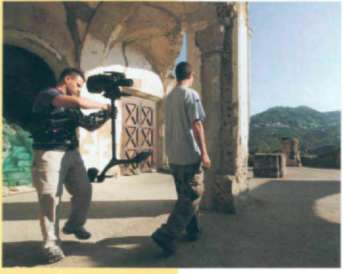
Line dances
We call ourexercises line dances for a reason: to emphasize the way we should learn to move with a Steadicam. In the workshops we teach, we often ask the students if they are in balance when they are holding the final frame at the end of a line. What often happens is that a new operator will be dancing and holding that tension as he goes along the line, but the dance stops when he stops. Just like in the tango, it is so important to Steadicam dancing to keep the tension and the balance when you stop and hold a locked frame. If you stop dancing, the shot falls apart. Dance until the director says, “Cut!” — and then hold a few more beats just for fun.
The Steadicam is a perfect dance partner
- The Steadicam wants to keep the tension constant.
- The Steadicam wants to go where you lead it
- The Steadicam never changes diiection withhut your permission.
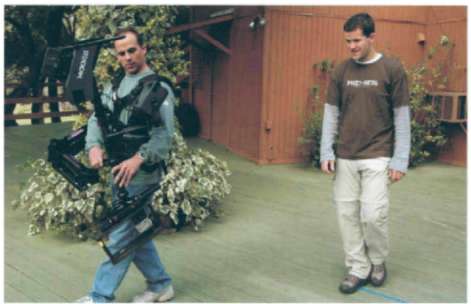
Is it possible that becoming a Steadicam operator can improve your success at dancing? This will have to be studied more in depth.
